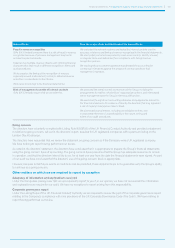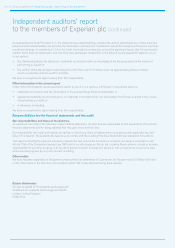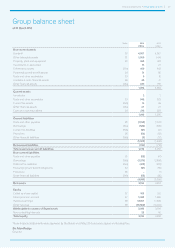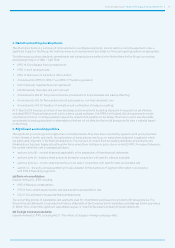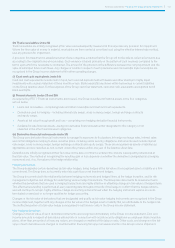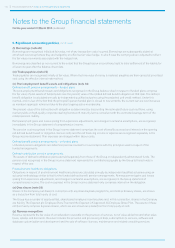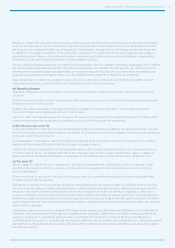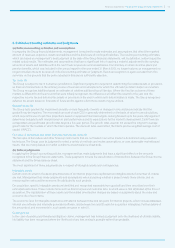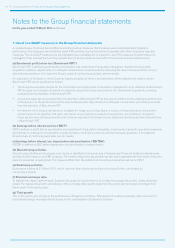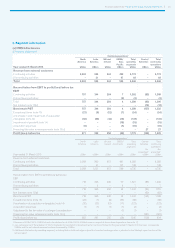Experian 2014 Annual Report Download - page 116
Download and view the complete annual report
Please find page 116 of the 2014 Experian annual report below. You can navigate through the pages in the report by either clicking on the pages listed below, or by using the keyword search tool below to find specific information within the annual report.
Financial statements • Notes to the Group financial statements
Notes to the Group financial statements
for the year ended 31 March 2014 continued
112
5. Significant accounting policies continued
(c) Fair value estimation
Experian follows EU-IFRS including IFRS 13 ‘Fair value measurement’. The fair values of derivative financial instruments and other
financial assets and liabilities are determined by using market data and established estimation techniques such as discounted cash
flow and option valuation models. The fair value of foreign exchange contracts is based on a comparison of the contractual and year
end exchange rates. The fair values of other derivative financial instruments are estimated by discounting the future cash flows to net
present values using appropriate market rates prevailing at the year end.
(d) Impairment of non-financial assets
Experian follows EU-IFRS, including IAS 36 ‘Impairment of assets’. Assets that are not subject to amortisation or depreciation are
tested annually for impairment. Assets that are subject to amortisation or depreciation are reviewed for impairment whenever events
or changes in circumstances indicate that the carrying amount may not be recoverable. An impairment charge is recognised for the
amount by which the asset’s carrying amount exceeds its recoverable amount. The recoverable amount is the higher of an asset’s
fair value less costs to sell, and value-in-use. For the purposes of assessing impairment, assets are grouped into cash generating
units (‘CGUs’), determined by the lowest levels for which there are separately identifiable cash flows.
(e) Goodwill (note 20)
Experian follows EU-IFRS, including IAS 38 ‘Intangible assets’.
(f) Other intangible assets (note 21)
Experian follows EU-IFRS, including IAS 38 ‘Intangible assets’.
Acquisition intangibles
Intangible assets acquired as part of a business combination are capitalised on acquisition at fair value separately from goodwill,
if those assets are identifiable, separable or arise from legal rights and their fair value can be measured reliably. Such assets are
referred to as acquisition intangibles in these financial statements. Amortisation is charged on a straight-line basis as follows:
• Customer and other relationships – over three to 18 years, based on management’s estimates of the average lives of such
relationships; and
• Acquired software development – over three to eight years, based on the expected life of the asset.
Marketing-related assets:
• Trademarks and licences – over their contractual lives up to a maximum period of 20 years; and
• Trade names – over three to 14 years, based on management’s expected retention of trade names within the business.
Other intangibles
Other intangibles are capitalised at cost, in accordance with IAS 38. Capitalisation and amortisation policies are:
• Databases – capitalised databases, which comprise the data purchase and data capture costs of internally developed
databases, are amortised over three to seven years.
• Computer software (internal use software) – computer software licences purchased for internal use are capitalised on the basis
of the costs incurred to purchase and bring into use the specific software. These costs are amortised over three to ten years.
• Computer software (internally generated software) – costs that are directly associated with the production of identifiable and
unique software products controlled by the Group, and that will generate economic benefits beyond one year, are recognised
as intangible assets. These costs are amortised over three to ten years.
(g) Property, plant and equipment (note 22)
Items of property, plant and equipment are held at cost less accumulated depreciation, in accordance with IAS 16 ‘Property,
plant and equipment’. Depreciation is charged on a straight-line basis as follows:
• Freehold properties – over 50 years;
• Short leasehold properties – over the remaining period of the lease;
• Finance leases – over the lower of the useful life of the equipment and period of the lease; and
• Other plant and equipment – over three to ten years according to the estimated life of the asset. Technology-based assets
are typically depreciated over three to five years with other infrastructure assets depreciated over five to ten years.



